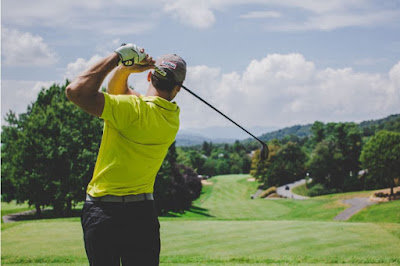Golf is a dynamic sport that engages muscles throughout the body. From the external obliques to the muscles located in your forearm, golf requires coordination and strength. Although strength is a crucial part of improving your golf game, many people still believe that they can succeed by just practicing - as important as it is to temper the mind, it is also important to consider proper strength training if you are serious about scoring well.
Practicing with a purpose is extremely important - you expand your ability to play well when you incorporate strength training into your weekly regimen.
In this guest post by Brian from Home Gym Strength, Golf for Beginners helps you realize the benefits of strength training in your overall golf game. In addition, Brian will explain some of the best exercises that golfers should incorporate into their routine.
Benefit 1 of Strength Training for Golf: Increased Mobility
A proper golf swing requires a wide range of motion. In order to move your body fluidly, you must have flexibility and mobility. Two important parts of any strength training regimen are stretching and engaging in functional exercises. Stretching allows your body to become more flexible. When you increase flexibility, you will likely be able to increase the power and length of your backswing. In addition to increased power, mobility allows you to change the mechanics of your swing. When you have enhanced mobility, you are not limited to one type of swing.
Benefit 2 of Strength Training for Golf: Improved Coordination
When you engage in strength training, your muscles learn to work cohesively. Through training, muscles are activated and begin to work efficiently. When your muscles are engaged, they are likely going to work together in unison, enhancing strength and coordination.
You never work just one individual muscle, every movement is composed of fibers from many different muscles. In order to maintain coordination, all muscles need to learn how to work together. In golf, it is crucial that you have good hand-eye coordination. As you activate the muscles in your body through your swing, the muscles in your brain direct your body where to point, shoot, and hit the ball. This coordination is potentially the most important aspect of golf. By strength training, your body will fall into a rhythm of coordination.
When you have more strength in your arms, legs, and core, you will be able to drive the ball further down the field. Not only must you have balance and coordination, you also must have the power to send the ball flying across the course.
Many people believe that if they can strengthen their forearms then they will thrive in their golf game. If you want more power in your swing, you must strengthen your abdominal and leg muscles. Your legs are used to support your body as you move forward into your swing. The muscles in your core are needed to position your torso correctly so that your ball can reach the green. Powerful swings start with a robust, full-body strengthening regimen.
Best Strength Training Exercises for Golfers
There are many great strength training exercises that golfers can complete to take their game to the next level. The three categories of muscles that are crucial for golfers are:
Abdominals and Obliques
Upper Body - Forearm, Shoulders, Upper Back
Hamstrings and Quadriceps
Many people do not recognize that golf is a sport that requires full-body strength. There are exercises in each muscle group that will help you improve your game today.
Abdominals and Obliques - Core Exercises for Golfers
It is important to find exercises that work the entirety of your core. A strong core will stabilize your body as you swing the golf club. Some of the best core exercises for golfers include:
Side Plank
Russian Twist
Glute Bridges
By engaging in these exercises, you will activate muscles throughout your entire core.
Upper Body Strength
Your upper body plays a huge role in the power of your golf swing. As these muscles strengthen, they help to reduce any tension being held in the lower back. Some of the most effective upper body exercises for golfers include:
Push-ups
Bench Presses
Preacher Curls
When you work your upper body, it is important to engage the muscles in both your shoulders and your back. For golfers, it is important to complete exercises that increase the strength of their forearms.
Your leg muscles help you to complete a controlled, strong golf swing. By working the muscles in your legs, you are more likely to keep your body in the correct position for the entirety of your swing. The following leg exercises are effective for golfers:
Single Leg Deadlifts
Back Squats
Reverse Lunges
These exercises fire up your hamstrings and quadriceps. By focusing on these muscle groups, you will see improved posture and power in your golf game.
Conclusion
Strength training is one of the most underrated components of an improved golf game. As people gain strength and coordination, they are likely to see more power in their swing. Strength training routines should include exercises that work muscles throughout the core, legs, and upper body. Do not be worried if you do not have a gym to go to during COVID or when you are out of your daily grind - the majority of these exercises can be done in the comfort of your home. By engaging the muscle groups throughout your body, you can take your golf game to the next level.




